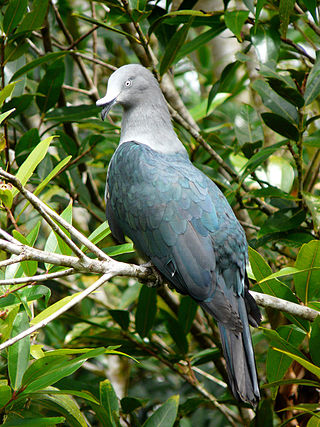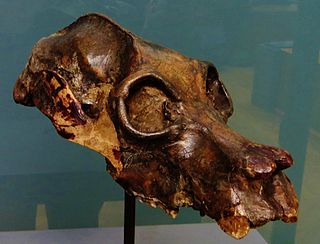
Columbidae is a bird family consisting of doves and pigeons. It is the only family in the order Columbiformes. These are stout-bodied birds with short necks and short slender bills that in some species feature fleshy ceres. They primarily feed on plants, and can be taxonomically divided amongst granivores, that feed mostly on the ground on seeds, and frugivores, that feed mostly on fruits, from branches. The family occurs worldwide, often in close proximity with humans, but the greatest variety is in the Indomalayan and Australasian realms.

The genus Brachylophus consists of four extant iguanid species native to the islands of Fiji and a giant extinct species from Tonga in the South West Pacific. One of the extant species, B. fasciatus, is also present on Tonga, where it has apparently been introduced by humans.

Caloenas is a genus of pigeons. The only living species is the Nicobar pigeon.

The Marquesan imperial pigeon, also known as the Nukuhiva imperial-pigeon, Nukuhiva pigeon or Upe, is a pigeon which is endemic to Nuku Hiva in the Marquesas Islands of French Polynesia. This pigeon is only found in some valleys in the western part of that island.

Gallirallus is a genus of rails that live in the Australasian-Pacific region. The genus is characterised by an ability to colonise relatively small and isolated islands and thereafter to evolve flightless forms, many of which became extinct following Polynesian settlement.

The blue pigeons are a genus, Alectroenas, of birds in the dove and pigeon family Columbidae. They are native to islands in the western Indian Ocean.

Ducula is a genus of the pigeon family Columbidae, collectively known as imperial pigeons. They are large to very large pigeons with a heavy build and medium to long tails. They are arboreal, feed mainly on fruit and are closely related to the other genus of fruit-eating doves, Ptilinopus. Both genera display brightly coloured plumage, predominantly green, often with contrasting under-parts of purple, orange or red. Some Ducula have prominently swollen ceres. They have large gapes and swallow seeds whole, playing an important role in seed dispersal.

The barking imperial pigeon, also known as Peale's imperial pigeon, is a species of bird in the pigeon family Columbidae. It is endemic to Fiji, where it occurs on most of the medium and large islands.

The Pacific imperial pigeon, Pacific pigeon, Pacific fruit pigeon or lupe is a widespread pigeon species in the family Columbidae. It is found in American Samoa, the Cook Islands, the smaller islands of eastern Fiji, Kiribati, Niue, the smaller satellite islands of Papua New Guinea, Samoa, Solomon Islands, Tokelau, Tonga, Tuvalu, Vanuatu, and Wallis and Futuna Islands.

The white-capped fruit dove, also called kuku locally, is a species of bird in the family Columbidae. It was described by French naturalist and surgeon Adolphe-Simon Neboux in 1840. It is endemic to the Marquesas Islands in French Polynesia. The name honours French admiral and botanist Abel Aubert du Petit-Thouars. Two subspecies exist on the islands, Ptilinopus d. dupetithouarsii and Ptilinopus d. viridior.

The many-colored fruit dove, also known as manuma in the Samoan language, is a species of bird in the family Columbidae. It occurs on islands in the south-west Pacific Ocean where it is found in Fiji, the Samoan Islands, and Tonga. Its natural habitat is subtropical or tropical moist lowland forests. Today, the birds are most often found in Fiji and Tonga. It usually feeds high in the canopy on fruit and berries, especially banyan fig. The nest is a small platform of twigs where one white egg is laid.

The oceanic eclectus is an extinct parrot species which occurred on Tonga, Vanuatu and possibly on Fiji. Its only living relative is the eclectus parrot, which has proportionally larger wings than the oceanic eclectus parrot. The fossil material unearthed in November 1989 in Late Pleistocene and Holocene deposits on 'Eua, Lifuka, 'Uiha and Vanuatu and described in 2006 by David William Steadman include a complete femur, five radii, a quadrate bone, a mandible, a coracoid, two sterna, two humeri, two ulnae, two tibiotarsi, a carpometacarpus, a tarsometatarsus, and three pedal phalanges.

The spotted green pigeon or Liverpool pigeon is a species of pigeon which is most likely extinct. It was first mentioned and described in 1783 by John Latham, who had seen two specimens of unknown provenance and a drawing depicting the bird. The taxonomic relationships of the bird were long obscure, and early writers suggested many different possibilities, though the idea that it was related to the Nicobar pigeon prevailed, and it was therefore placed in the same genus, Caloenas. Today, the species is only known from a specimen kept in World Museum, Liverpool. Overlooked for much of the 20th century, it was recognised as a valid extinct species by the IUCN Red List only in 2008. It may have been native to an island somewhere in the South Pacific Ocean or the Indian Ocean, and it has been suggested that a bird referred to as titi by Tahitian islanders was this bird. In 2014, a genetic study confirmed it as a distinct species related to the Nicobar pigeon, and showed that the two were the closest relatives of the extinct dodo and Rodrigues solitaire.

Pachylemur is an extinct, giant lemur most closely related to the ruffed lemurs of genus Varecia. Two species are known, Pachylemur insignis and Pachylemur jullyi, although there is some doubt as to whether or not they may actually be the same species. Pachylemur is sometimes referred to as the giant ruffed lemur, because although it and the living ruffed lemurs had similar teeth and skeletons, Pachylemur was more robust and as much as three to four times larger. DNA studies have confirmed a sister group relationship between these two types of lemur. Like living ruffed lemurs, Pachylemur specialized in eating fruit, and was therefore an important seed disperser, possibly for tree species with seeds too large for even ruffed lemurs to swallow. In the spiny thickets of southwestern Madagascar, they were also likely to have dispersed seeds evolved to attach to fur and be carried away. Unlike ruffed lemurs, the fore- and hindlimbs of Pachylemur were nearly the same length, and therefore it was likely to be a slow, deliberate climber. However, both used hindlimb suspension to reach fruit on small branches below them.

Subfossil lemurs are lemurs from Madagascar that are represented by recent (subfossil) remains dating from nearly 26,000 years ago to approximately 560 years ago. They include both extant and extinct species, although the term more frequently refers to the extinct giant lemurs. The diversity of subfossil lemur communities was greater than that of present-day lemur communities, ranging to as high as 20 or more species per location, compared with 10 to 12 species today. Extinct species are estimated to have ranged in size from slightly over 10 kg (22 lb) to roughly 160 kg (350 lb). Even the subfossil remains of living species are larger and more robust than the skeletal remains of modern specimens. The subfossil sites found around most of the island demonstrate that most giant lemurs had wide distributions and that ranges of living species have contracted significantly since the arrival of humans.

Brachylophus gibbonsi is an extinct species of large iguanid lizard from Tonga in the South Pacific Ocean. Its remains have been found associated with cultural sites on Lifuka, four other islands in the Haʻapai group, and Tongatapu. It was consumed by the early Tongans and probably became extinct within a century of human colonization of the archipelago 2800 years ago.

The Mascarene grey parakeet, Mauritius grey parrot, or Thirioux's grey parrot, is an extinct species of parrot which was endemic to the Mascarene Islands of Mauritius and Réunion in the western Indian Ocean. It has been classified as a member of the tribe Psittaculini, along with other parrots from the Islands.

Ptilinopinae is a subfamily of birds from the family Columbidae.

The Tongan tooth-billed pigeon, is an extinct species of pigeon that was endemic to Tonga that lived in the Quaternary period. A related species, the tooth-billed pigeon, is the only known living species in its genus.




















